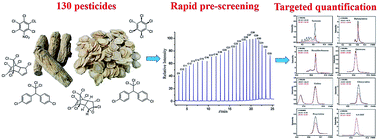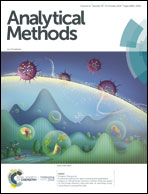A practical method for rapid screening and quantitative analysis of 130 pesticide residues in herbal medicines based on the Kovats retention index principle: an exemplary study using Panacis quinquefolii radix†
Abstract
There are still some difficulties in accurately quantifying pesticide residues in herbal medicines. One difficulty is the rapid screening of the existing unknown pesticide species in samples. Another difficulty is the accurate identification of the target pesticide under the severe interference of complex components in herbs. In this study, we have developed a very novel and practical analytical method for 130 pesticide residues based on the retention index principle, and an exemplary study was performed using Panacis quinquefolii radix. This newly developed method has two significant advantages for pesticide residue analysis. One of the advantages is the ability to quickly pre-screen pesticides in samples without necessarily requiring a large amount of standard solution. This means that the efficiency of the pesticide analysis can be improved and the cost of testing can be greatly reduced. Another advantage is that this method can help researchers accurately identify target pesticides, which means that the accuracy of pesticide analysis can be improved. In summary, this study is a new utilization of the Kovats retention index, and this method will be a very promising tool for pesticide residue analysis in herbal medicines.



 Please wait while we load your content...
Please wait while we load your content...